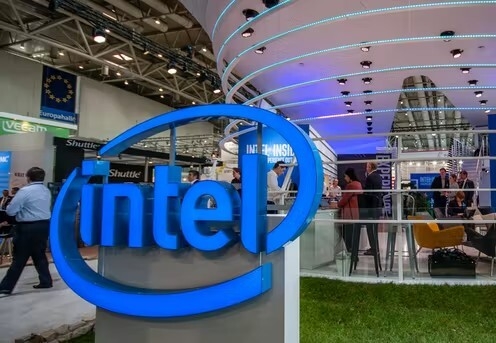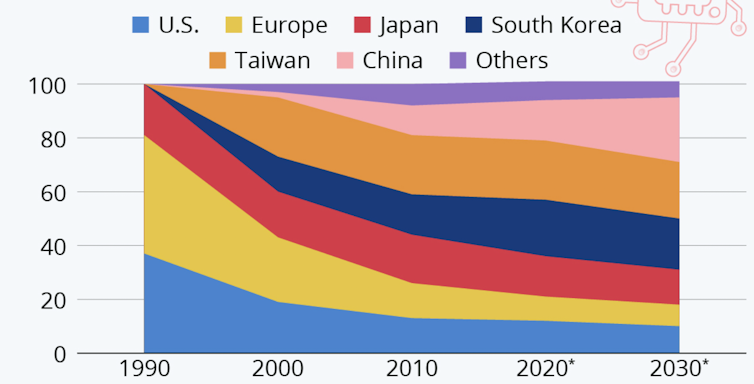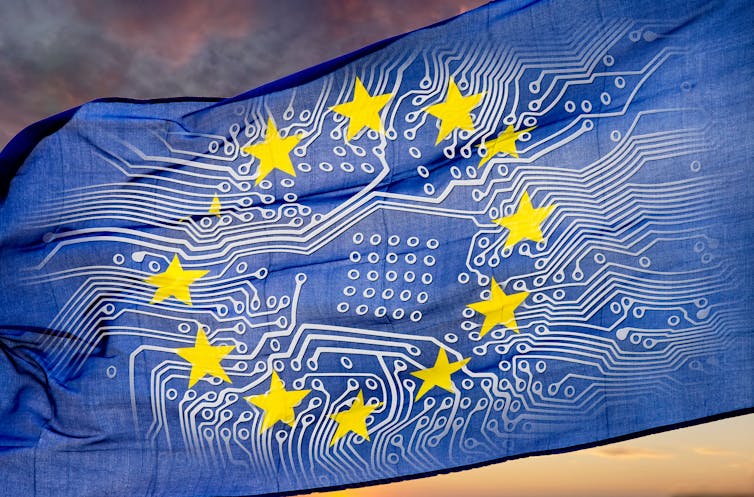Intel’s proposed US$30 billion (£23 billion) investment in semiconductor manufacturing capacity across Europe has the potential to significantly boost the continent’s struggling chip industry.
The US giant is poised to invest an initial US$17 billion to build a cutting-edge semiconductor factory (known as a fab) in Germany, along with associated R&D facilities to develop new generations of chips in France, Ireland and Poland. It is also in negotiations with the Italian government to develop a manufacturing facility in that country.
If such proposals come to fruition, the overall investment could top US$80 billion and create over 3,000 high-tech jobs and many more across the digital supply chain. Intel, the relevant national governments and the European Commission argue that these investments will transform Europe’s semiconductor supply chain and make it more competitive. The role of national governments and the European Commission is important to note as Intel’s investment is likely to be underpinned by billions of euros worth of public subsidies.
Chip production has been high on Europe’s agenda as many high-technology companies have been struggling to source chips because the COVID-19 pandemic has disrupted worldwide supplies. Europe’s automotive industry has been particularly hindered as a result. Russia’s invasion of Ukraine has accentuated the problem because the industry relies on both nations for neon, which is vital for the lasers used to cut state-of-the-art chips.
Intel’s investment in new capacity is not going to address these current issues, given that production is not expected to begin until 2027. But it could eventually ease Europe’s dependency on sourcing chips from afar and revitalise the continent’s increasingly uncompetitive operations.
The world market
The semiconductor industry is global in scope, with nearly two-thirds of chips manufactured in Asia – particularly South Korea, Taiwan, Japan and China. This dominance has come at the expense of European producers, which now account for only around 8% of the world market, compared to 44% in 1990. This is largely the result of under-investment.
Principally as a result of heightened geopolitical instability, the EU has recently become concerned about “digital sovereignty”. Its recent European Chips Act set out a range of measures to boost European production by pooling different countries’ resources to complement their individual research strengths. It also supports developing new production facilities with a view to increase Europe’s share of the global market to 20% by 2030.
Boston Consulting/Semiconductor Industry Association
Intel’s announced investment is the most tangible outcome to date and is certainly welcome, though it is unlikely to fully rekindle the European industry alone. The industry tends to be populated by SMEs (smaller businesses) clustered in a small number of locations, including Leuven (Belgium), Dresden (Germany), Eindhoven (Netherlands), Grenoble (France) and Cardiff (UK).
Our recent research into these clusters suggests that many companies have been starved of investment from either private or public sources to expand and innovate. This is compounded by a lack of demand from European technology companies.
For example, with the demise of Nokia, Europe no longer has a giant company such as Apple or Samsung that demands the most sophisticated chips. For many of Europe’s semiconductor companies, which are engaged in chip design rather than production, these issues are stifling the growth of the industry more than a lack of manufacturing capacity.
What needs to happen
To address this, the Intel intervention needs to form part of a coherent and integrated strategy to boost the competitiveness and innovation capacity of the European sector as a whole. Like other deep tech sectors, the chip industry is increasingly an entrepreneurial one. New and innovative ideas are sparked by start-up companies that are able to commercialise these ideas and create value.
There is a very real need to provide business and infrastructure support, as well as skills development and commercialisation routes to allow start-ups to enter the industry and current incumbents to upgrade and scale up.
Chips off the old bloc. gopixa
Innovation is clearly the name of the game when it comes to competitiveness in chip-making. To give the European Commission its due, it has provided significant funding for semiconductor research over a number of years through the Framework and Horizon programmes. However, successful commercialisable innovations stemming from this research have been relatively sparse.
Therefore, alongside supporting large, foreign direct investment projects there must be an enhanced focus on improving the entrepreneurial and innovative capabilities and capacity across Europe’s semiconductor industry. Without this, there is a real danger that due to a lack of significant viable demand in future, we will be reading news of the mothballing of the proposed new manufacturing facilities.



 Apple’s App Store Now Features Gaming Emulators for iPhone
Apple’s App Store Now Features Gaming Emulators for iPhone  Expert Warns: Altcoin Dip Buying Riskier Than It Appears, Cites Historical Data
Expert Warns: Altcoin Dip Buying Riskier Than It Appears, Cites Historical Data  Solana's OI Drops $440M, Yet Prices Climb Amid Wider Crypto Slump
Solana's OI Drops $440M, Yet Prices Climb Amid Wider Crypto Slump  Shiba Inu's Lucie Unveils 'DAMN' and 'PIKA' Tokens, Fuels Crypto Market Optimism
Shiba Inu's Lucie Unveils 'DAMN' and 'PIKA' Tokens, Fuels Crypto Market Optimism  Samsung Boosts U.S. Presence with $45bn Investment, Receives $6.4bn Government Grant
Samsung Boosts U.S. Presence with $45bn Investment, Receives $6.4bn Government Grant  Adobe Unveils Acrobat AI Assistant Tool for Acrobat and Reader Users
Adobe Unveils Acrobat AI Assistant Tool for Acrobat and Reader Users  Apple's iPhone 17 May Miss 2nm Chip Upgrade, Eyeing iPhone 18 Instead
Apple's iPhone 17 May Miss 2nm Chip Upgrade, Eyeing iPhone 18 Instead  Doosan Robotics, LG Electronics Debut EV Charging Robot, Kicks Off Pilot Operation in South Korea
Doosan Robotics, LG Electronics Debut EV Charging Robot, Kicks Off Pilot Operation in South Korea  Changpeng Zhao Faces Sentencing, Crypto Community Watches Anxiously
Changpeng Zhao Faces Sentencing, Crypto Community Watches Anxiously  Markets Teeter as 10x Research Predicts Sharp Decline in Stocks, Crypto
Markets Teeter as 10x Research Predicts Sharp Decline in Stocks, Crypto  Analyst Predicts Bitcoin Could Reach $650K with New Hong Kong ETFs
Analyst Predicts Bitcoin Could Reach $650K with New Hong Kong ETFs  Huawei HarmonyOS NEXT User Interface Leaks, Sets April 18 Launch for Pura 70 Series
Huawei HarmonyOS NEXT User Interface Leaks, Sets April 18 Launch for Pura 70 Series  Bitcoin Fees Soar to $11M as Halving Event Nears, Hash Rate Spikes
Bitcoin Fees Soar to $11M as Halving Event Nears, Hash Rate Spikes  Tesla Model Y LR Takes on Law Enforcement Role in Anaheim
Tesla Model Y LR Takes on Law Enforcement Role in Anaheim  Spotify Hints at Long-Awaited Lossless Music Experience in Latest App Code Discovery
Spotify Hints at Long-Awaited Lossless Music Experience in Latest App Code Discovery  Fiji Central Bank Cautions on Crypto Use, Dashing Bitcoin Integration Hopes
Fiji Central Bank Cautions on Crypto Use, Dashing Bitcoin Integration Hopes  Shibarium's Transaction Count Soars to Nearly 1 Million in Record Surge
Shibarium's Transaction Count Soars to Nearly 1 Million in Record Surge 


































